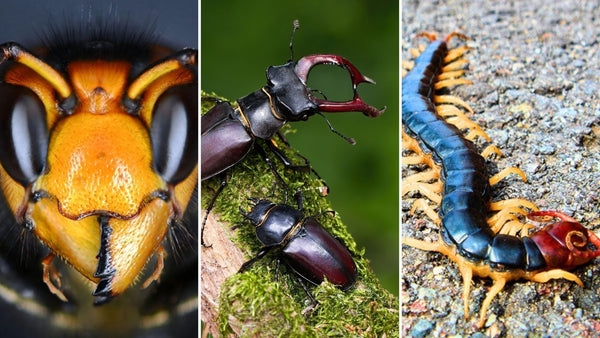
Jump to:
Japan’s natural world is full of surprises, and its Japanese insects are no exception. From glowing fireflies in summer and the rhythmic calls of cicadas to the weird insects and scary bugs that sometimes startle newcomers, insects in Japan play a much bigger role than simply buzzing in the background.
Many species are tied to folklore, seasonal traditions, and even cuisine, making the world of mushi (the Japanese word for insects) an unexpectedly fascinating part of Japanese culture.
Whether you’re curious about the notorious Japanese centipede (mukade), often ranked among the scariest bugs in the country, or you simply want to know what to do if a rhinoceros beetle lands on your arm, this guide will help you understand, appreciate, and safely navigate Japan’s diverse insect life.
1. Cicadas (Semi-mushi) - The Sound of Summer

- Season: July to September
- Habitat: Across Japan, especially near cherry blossom trees
- Danger Level: Harmless, but noisy
In Japan, cicadas are the quintessential sound of summer, usually emerging after the rainy season in late July and peaking through mid-August. Compared to other countries, Japanese cicadas are especially loud, particularly the kuma-semi or bear cicada that inhabits the more boisterous Kansai region.
There are around 30 cicada species nationwide, but the medium-sized minmin-zemi make the iconic “miin-miin-min” sound heard in summer anime and films. Children often head out with nets and insect boxes on cicada hunts, sometimes startling slumbering train passengers when their box contents get jolted!
2. Rhinoceros Beetle (Kabuto-mushi) - The Samurai Beetle

- Season: June to August
- Habitat: Central and southern Japan, especially in forests and rural parks
- Danger Level: Harmless
Rhinoceros beetles, with their distinctive horns, are summer superstars. The Japanese name kabuto-mushi means “samurai helmet” (kabuto) and “insect” (mushi). Kids, and some adults, collect these nocturnal insects using fruit traps or flashlights at night. Pet shops even sell them with special beetle jelly food.
Despite their imposing armor, kabuto-mushi are gentle, slow-moving, and feed mainly on tree sap and overripe fruit. A childhood pastime involves staging non-lethal “beetle sumo” matches between males on a log, where one tries to flip the other off. Kabuto-mushi frequently appear in anime, manga, and children’s TV shows featuring Japanese insects.
3. Stag Beetle (Kuwagata) - Forest Champion

- Season: Early summer to mid-autumn
- Habitat: Mountainous forests, especially in Nagano, Gifu, and Shizuoka
- Danger Level: Harmless, but can pinch!
The stag beetle, named for its dramatic antlers, is another beetle mania favorite in Japan. Males use their jaws to wrestle rivals in territorial displays, and children take advantage of this behavior, erecting miniature beetle-fighting arenas for fun. The Japanese name kuwagata means “hoe-shaped,” though its silhouette also recalls a samurai helmet.
Kuwagata play an important role in forest health because they feed on decaying wood deep inside fallen logs and roots. In 2003, an arcade game franchise, Kochu Oja Mushiking, combined an arcade machine with collectible beetle cards. It became a massive craze with elementary school boys and even inspired a manga and anime series.
4. Fireflies (Hotaru) - Magical Wonderlands

- Season: One or two weeks from mid-June, usually from 19:30 to 21:00
- Habitat: Rural riversides, streams, and wet fields
- Danger Level: Harmless
Out of all Japanese insects, fireflies are the most cherished by people of all ages. Called hotaru, they are actually beetles. The larvae and certain wingless female varieties may resemble glow-worms. They appear around the start of the rainy season in mid-June, and the most famous species are the genji-botaru and heike-botaru.
In popular culture, they symbolize love, purity, and fleeting beauty. Fireflies are traditionally believed to be the souls of fallen warriors or the spirits of the dead. Hotaru no Haka (Grave of the Fireflies, 1988), directed by Isao Takahata, a co-founder of Studio Ghibli, beautifully evokes this symbolism.
Some famous firefly-viewing locations include Shiga Kogen’s Ishi-no-Yu in Nagano, the Hokubo Firefly Park in Okayama, and the Fussa Firefly Park in western Tokyo.
5. Bell Cricket (Suzumushi) - The Sound of Fall

- Season: Late August to October
- Habitat: Grassy fields, temple gardens, and riversides
- Danger Level: Harmless
As summer fades and the air cools, the bell-like song of the suzu-mushi echoes through Japan’s evenings. This small brown cricket is cherished not for its looks but for its ‘voice’. Males produce a clear, metallic “rin-rin” sound by rubbing their wings together. The pitch is so high that many microphones struggle to record it clearly.
Symbolically, Suzumushi is the title of Chapter 38 of The Tale of Genji, featuring a romantic and somber exchange between its main characters. Its sound has inspired haiku, songs, and Buddhist metaphors about impermanence. Kyoto’s Myotokuzan Kegonji Temple — nicknamed Suzumushi-dera, has found a way to breed these crickets so visitors can hear their song year-round, not just in the Fall.
6. Japanese Giant Hornet (Suzumebachi) - Handle with Care

- Season: August to October
- Habitat: Rural forests, mountain trails, and some suburban gardens
- Danger Level: Highly dangerous
The suzume-bachi, or Japanese giant hornet, has a fearsome reputation. As the world’s largest hornet (up to 5 cm long), it delivers one of the most painful stings known. Its orange-and-black body and deep hum are unmistakable. Though attacks are rare, it’s best to stay calm and back away slowly if one approaches. Avoid wearing perfumes, dark colors like black or navy, or bright reds and yellows when hiking, as these can attract them.
Despite their danger, these hornets play a vital ecological role by preying on crop pests—although they can devastate bee colonies. A sting requires immediate care by disinfecting the entry point, applying a cold compress, and maybe even taking an antihistamine. People with allergies should carry an EpiPen, and multiple stings can affect the kidneys, heart, and liver.
7. Japanese Centipede (Mukade) - The Venomous Intruder

- Season: Late spring through autumn
- Habitat: Humid regions, forests, traditional houses, and even bathrooms
- Danger Level: Venomous, painful, but rarely fatal
The mukade, or Japanese centipede, is the stuff of bug lore. They have 21 to 23 pairs of legs, and the largest species often reach 15 to 20 cm in length. You can recognize them by their glossy black bodies, red heads, and yellow legs.
In Japanese culture, the mukade is often seen as the messenger of Bishamonten, god of warriors. Many samurai adopted it as a symbol on their banners and helmets. In folklore, the giant Omukade wrapped itself around Mount Mikami to torment the Dragon King. Modern anime also feature Omukade, notably Inuyasha and One Punch Man.
If bitten by a Japanese centipede, you should immediately wash the area with hot, soapy water. Applying a heat pack can help neutralize the venom, followed by an antihistamine cream.
8. Japanese Bumblebee (Maruhanabachi) - Japan’s Gentle Pollinator

- Season: March to October (most active in spring and early summer)
- Habitat: Across Honshu, Hokkaido, Shikoku, and Kyushu, especially in highland meadows and forest edges
- Danger Level: Non-aggressive unless threatened
Among the diversity of Japanese insects, the bumblebee stands out as a quiet hero. Stocky and fuzzy, with black and yellow stripes, the Japanese bumblebee is one of the country’s key native pollinators for wildflowers, fruit trees, and alpine plants. The name maruhanabachi means “round flower bee.”
Unlike imported honeybees, Japanese bumblebees thrive in colder weather and overcast conditions, making them invaluable for early spring pollination. The Japanese carpenter bee (kumabachi), by contrast, is solitary, larger, and glossy black, more ‘bear bee’ than bumblebee.
9. Dragonflies (Tonbo) - The Autumn Herald
- Season: Late summer to October
- Habitat: Near ponds, rice fields, and rivers nationwide
- Danger Level: Harmless
Graceful and agile, dragonflies are beloved in Japanese folklore as symbols of courage and victory. Samurai once used them as emblems on armor, believing they could only fly forward, never backward. Red akane-tonbo drifting over rice paddies signal the changing season from summer to autumn. They neither sting nor bite and are a favorite of photographers and insect enthusiasts.
10. Jewel Beetle (Tamamushi) - The Bug of Shining Wings

- Season: Summer to early autumn
- Habitat: Warm forests, temple groves, and wooded areas across Honshu and Kyushu
- Danger Level: Harmless
The tama-mushi, or jewel beetle, is one of Japan’s most dazzling insects. Its wings shimmer with iridescent hues of green, gold, and violet that change with the light. The name tama-mushi literally means “jeweled insect,” and for centuries it has symbolized beauty, mystery, and the fleeting nature of perfection.
Its most famous appearance is in the miniature Tamamushi Shrine at Horyu-ji Temple in Nara, a 7th-century national treasure named after the jewel beetle wings that once decorated its surface. These lustrous wing cases were prized in ancient craftsmanship, adorning Buddhist regalia, hair ornaments, and lacquer boxes.
Other Things to Know About Japanese Insects
Are there any Dangerous or Annoying Insects in Japan?

Yes, aside from the well-known mukade centipede and giant hornet, travelers often encounter mosquitoes, which are as pesky in Japan as anywhere else, though dengue outbreaks are rare and quickly contained.
Two types of caterpillars, such as the brown-tail moth (chadokuga) and the flannel moth caterpillar (denki-mushi) can cause painful rashes due to their venomous hairs or spines, especially in late spring and midsummer.
In humid, rural hiking areas, ticks and leeches are also common, with tick-borne illnesses more frequently reported in western Japan.
Which Japanese Insects are Unique to Japan?

Japan is home to several beautiful endemic species found nowhere else. The Yaeyama glow-worm illuminates Okinawa’s limestone caves with a constellation-like glow.
The Gifu butterfly, often called the goddess of spring, emerges early with striking yellow-and-black wings. Central Honshu’s pristine rivers host the delicate Hida firefly, a species long celebrated in poetry.
And the Nebuto stag beetle, hort-bodied, glossy, and muscular, is a compact, tank-like standout among beetles.
Do the Japanese Eat Insects?

Yes, but it’s primarily a regional tradition rather than a nationwide practice. In mountainous prefectures like Nagano and Gifu, edible insects have been part of rural cuisine for generations.
Dishes include inago—grasshoppers simmered in sweet soy sauce until caramelized along with hachi-no-ko, a savory stew of bee larvae, and zaza-mushi, river larvae slowly simmered in dark soy sauce until glossy.
Recently, some chefs have begun reintroducing these traditions through modern dishes, including insect-based ramen in Tokyo, offering adventurous eaters a unique taste of Japan's food heritage.
Tips for Travelers to Japan
When exploring rural trails, forests, or grassy areas, long pants are your best defense against ticks, and it’s wise to avoid brushing against camellias and broad-leaved trees where caterpillars often linger. Strong perfumes, as well as dark colors like black and navy or bright reds and yellows, can attract hornets, so sticking to lighter, neutral clothing helps keep unwanted attention away.
If you’re staying in an older Japanese house or traditional inn near the woods, it’s a good habit to shake out your shoes before putting them on and check your futon before sleeping, since mukade centipedes can occasionally wander indoors.
Many locals keep a quiet “insect armory” on hand, such as gentle wipes for repelling bugs, soothing lotions for bites and stings, or classic mosquito coils and natural herbal incense commonly used on porches and campsites.
If you’d rather appreciate insects from a safe distance, Japan’s insectariums and museums offer the perfect alternative. The Nawa Insect Museum in Gifu houses the country’s largest insect collection, while Tokyo’s National Museum of Nature and Science, Gunma Insect World, and the Ishikawa Insect Museum provide engaging, hands-on exhibits for curious visitors of all ages.



0 comments